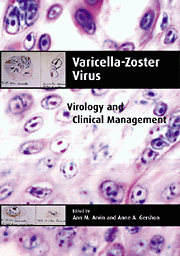Book contents
- Frontmatter
- Contents
- List of contributors
- Preface
- Introduction
- Part I History
- Part II Molecular Biology and Pathogenesis
- Part III Epidemiology and Clinical Manifestations
- Part IV Laboratory Diagnosis
- Part V Treatment and Prevention
- 18 Treatment of varicella
- 19 Treatment of herpes zoster
- 20 Management of postherpetic pain
- 21 Passive antibody prophylaxis
- 22 Development of the Oka vaccine
- 23 Primary immunization against varicella
- 24 Prevention of nosocomial transmission
- 25 Immunization against herpes zoster
- Index
- Plate section
19 - Treatment of herpes zoster
from Part V - Treatment and Prevention
Published online by Cambridge University Press: 02 March 2010
- Frontmatter
- Contents
- List of contributors
- Preface
- Introduction
- Part I History
- Part II Molecular Biology and Pathogenesis
- Part III Epidemiology and Clinical Manifestations
- Part IV Laboratory Diagnosis
- Part V Treatment and Prevention
- 18 Treatment of varicella
- 19 Treatment of herpes zoster
- 20 Management of postherpetic pain
- 21 Passive antibody prophylaxis
- 22 Development of the Oka vaccine
- 23 Primary immunization against varicella
- 24 Prevention of nosocomial transmission
- 25 Immunization against herpes zoster
- Index
- Plate section
Summary
Introduction
Herpes zoster in the intact (otherwise immunocompetent) host is generally a short duration inconvenience with local rash and pain the only problems. In certain cases the dermatome affected may be associated with an increased risk of complications (e.g. ocular problems with ophthalmic zoster or motor nerve paralysis in cervical or sacral involvement) and in the elderly there is a risk of chronic pain. On the other hand, in the immunocompromised host, specifically patients with profoundly depressed cell mediated immunity, the disease is not only more extensive and prolonged but there is also a risk of viraemia with widespread cutaneous and visceral dissemination. The aims of treatment in these two groups of patients are somewhat different.
In the intact host the aims are, firstly, to reduce the severity and duration of the acute symptoms by speeding the healing of the rash but, secondly, particularly in the elderly and others at high risk, to reduce the likelihood and duration of complications such as chronic neuralgia and ocular damage. These benefits are also of some importance in the immunocompromised patient but in these individuals the prime consideration is to prevent the morbidity and mortality associated with visceral dissemination of varicella-zoster virus (VZV).
Intact hosts
Drugs of choice
Since the manifestations of acute herpes zoster are caused by replication of VZV, inhibition of such replication is the most logical way of reducing disease severity. VZV is susceptible to several antiviral drugs and, at present, there are a number of orally active nucleoside analogs that are clinically effective in the treatment of herpes zoster in immunocompetent patients, provided they are started within 72h of onset of the rash.
- Type
- Chapter
- Information
- Varicella-Zoster VirusVirology and Clinical Management, pp. 396 - 411Publisher: Cambridge University PressPrint publication year: 2000
- 1
- Cited by

